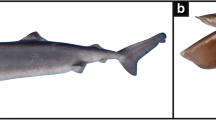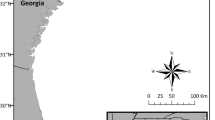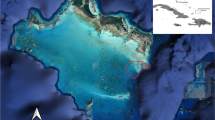Abstract
The broadnose sevengill shark (Notorynchus cepedianus) is a high-order marine predator distributed worldwide in shallow coastal waters of temperate seas. Recent reports have suggested it may be a prevalent component of Pacific Northwest coastal estuarine communities, although biological characteristics of the shark population remain undocumented despite growing interest in recreational harvest of the species. Longline sampling was conducted in Willapa Bay and Grays Harbor, Washington, USA seasonally during 2003–2006 to collect sevengill shark size, maturity, and sex ratio data, and establish some baseline catch rate information. Sevengill sharks were collected on 65% of longline sets and catches were composed of subadult and mature individuals (122–283 cm TL) of both sexes. Most male sevengill sharks were large sexually mature adults, based on external clasper calcification levels, whereas most comparably sized females were considered subadults, based on literature-based size-at–maturity estimates. Neonates and young sharks <120 cm were not collected, nor have they been reported in other historic estuary sampling efforts. Sex ratios were skewed toward males in Willapa Bay and suggest some degree of sexual segregation for the species, as has been shown for populations elsewhere. We suggest sevengill sharks are a largely ignored but potentially important predator in Pacific Northwest estuaries. This study therefore provides some of the first, basic information for guiding management decisions associated with a late-maturing, slow-growing shark species in these coastal habitats.





Similar content being viewed by others
References
Armstrong DA, Rooper C, Gunderson DR (2003) Estuarine production of juvenile Dungeness crab (Cancer mgister) and contribution to the Oregon-Washington coastal fishery. Estuaries 28:1174–1188
Banas NS, Hickey BM, MacCready P, Newton JA (2004) Dynamics of Willapa Bay, Washington: a highly unsteady, partially mixed estuary. J Phys Oceanogr 34:2413–2427
Barnett A, Redd KS, Frusher SD, Stevens JD, Semmens JM (2010a) Non-lethal method to obtain stomach samples from a large marine predator and the use of DNA analysis to improve dietary information. J Exp Mar Biol Ecol 393:188–192
Barnett A, Stevens JD, Frusher SD, Semmens JM (2010b) Seasonal occurrence and population structure of the broadnose shark Notorynchus cepedianus in coastal habitats of south-east Tasmania. J Fish Biol 77:1688–1701
Baum JK, Myers RA (2004) Shifting baselines and the decline of pelagic sharks in the Gulf of Mexico. Ecol Lett 7:135–145
Bonham K (1942) Records of three sharks on the Washington coast. Copeia 1942:264–266
Braccini JM (2008) Feeding ecology of two high-order predators from south-eastern Australia: the coastal broadnose and the deepwater sharpnose sevengill sharks. Mar Ecol Prog Ser 371:273–284
Braccini JM, Troynikov VS, Walker TI, Mollet HF, Ebert DA, Barnett A, Kirby N (2010) Incorporating heterogeneity into growth analyses of wild and captive broadnose sevengill sharks Notorynchus cepedianus. Aquat Biol 9:131–138
Cailliet GM, Goldman KJ (2004) Age determination and validation in Chondrichthyan fishes. In: Carrier J, Musick JA, Heithaus MR (eds) Biology of sharks and their relatives. CRC Press LLC, Boca Raton, pp 399–447
Compagno LJV (1984) Sharks of the world. An annotated and illustrated catalogue of shark species known to date. Part I (Hexanchiformes to Lamniformes). FAO, Rome.
Cortes E (1999) Standardized diet compositions and trophic levels of sharks. ICES J Mar Sci 56:707–717
Dayton PK (2003) The importance of the natural sciences to conservation. Am Nat 162:1–13
Dumbauld BR, Holder DL, Langness OP (2008) Do sturgeon limit burrowing shrimp populations in Pacific Northwest estuaries. Environ Biol Fishes 83:283–296
Ebert DA (1989) Life history of the sevengill shark, Notorynchus cepedianus Peron, in two northern California bays. Calif Fish Game 75:102–112
Ebert DA (1996) Biology of the sevengill shark Notorynchus cepedianus (Peron, 1807) in the temperate coastal waters of southern Africa. S Afr J Mar Sci 17:93–103
Ebert DA (2002) Ontogenetic changes in the diet of the sevengill shark (Notorynchus cepedianus). Mar Freshw Res 53:517–523
Ebert DA (2003) Sharks, rays and chimaeras of California. University of California Press, Berkeley, 297 pp
Emmett R, Llanso R, Newton J, Thom R, Hornberger M, Levings C, Copping A, Fishman P (2000) Geographic signatures of North American West Coast estuaries. Estuaries 23:765–792
Fowler SL, Cavanagh RD, Camhi M, Burgess GH, Cailliet GM, Fordham SV, Simpfendorfer CA, Musick JA (ed.). 2005. Sharks, rays and chimaeras: the status of the Chondrichthyan fishes. Status survey. IUCN, Gland, Switzerland and Cambridge, UK. x + 461 pp.
Gunderson DR, Armstrong DA, Shi Y, McConnaughey RA (1990) Patterns of estuarine use by juvenile English sole (Parophrys vetulus) and Dungeness crab (Cancer magister). Estuaries 13:59–71
Hart JL (1973) Pacific Fishes of Canada. Fish Res Board Can Bull 180:740
Hickey BM, Banas NS (2003) Oceanography of the US Pacific Northwest Coastal Ocean and estuaries with application to coastal ecology. Estuaries 26:1010–1031
Holden MJ, Raitt DFS (1974) Manual of fisheries science. Part 2—Methods of resource investigation and their application. pp. 255, FAO, Rome, Italy.
Huber HR, Jeffries SJ, Brown RF, DeLong RL, VanBlaricom G (2001) Correcting aerial survey counts of harbor seals (Phoca vitulina richardsi) in Washington and Oregon. Mar Mamm Sci 17:276–293
Jacoby DM, Busawon DS, Sims DW (2010) Sex and social networking: the influence of male presence on social structure of female shark groups. Behav Ecol 21:808–818
Jennings A, Jennings T, Bailey R (2003) Estuary management in the Pacific Northwest. Oregon State University, Corvallis, 126 pp
Kitchell JF, Essington TE, Boggs CH, Schindler DE, Walters CJ (2002) The role of sharks and longline fisheries in a pelagic ecosystem of the Central Pacific. Ecosystems 5:202–216
Knip DM, Heupel MR, Simpfendorfer CA (2010) Sharks in nearshore environments: models, importance, and consequences. Mar Ecol Prog Ser 402:1–11
Kritzer JP, Sale PF (2006) Marine metapopulations. Academic, San Diego, 544 pp
Levin PS, Fogarty MJ, Murawski SA, Fluharty D (2009) Integrated ecosystem assessments: developing the scientific basis for ecosystem-based management of the ocean. PLoS Biol 7:e1000014. doi:10.1371/journal.pbio.1000014
Lucifora LO, Menni RC, Escalante AH (2005) Reproduction, abundance and feeding habits of the broadnose sevengill shark Notorynchus cepedianus in north Patagonia, Argentina. Mar Ecol Prog Ser 280:237–244
Moser ML, Lindley ST (2006) Use of Washington estuaries by subadult and adult green sturgeon. Environ Biol Fishes 79:243–253
Myers RA, Baum JK, Shepherd TD, Powers SP, Peterson CH (2007) Cascading effects of the loss of apex predatory sharks from a coastal ocean. Science 315:1846–1850
Parrish JK, Bailey R, Copping AE, Stein JE (2003) The Pacific Northwest coastal ecosystems regional study. Estuaries 26:991–993
Pikitch EK, Santora C, Babcock EA, Bakun A, Bonfil R, Conover DO, Dayton P, Doukakis P, Fluharty D, Heneman B, Houde ED, Link J, Livingston PA, Mangel M, McAllister MK, Pope J, Sainsbury KJ (2004) Ecosystem-based fishery management. Science 305:346–347
Pope KL, Kruse CG (2007) Condition. In: Guy CS, Brown ML (eds) Analysis and interpretation of freshwater fisheries data. American Fisheries Society, Bethesda
Reusink JL, Roegner GC, Dumbauld BR, Newton JA, Armstrong DA (2003) Contribution of coastal and watershed energy sources to secondary production in a Northeastern Pacific estuary. Estuaries 26:1079–1093
Reusink JL, Feist BE, Harvey CJ, Hong JS, Trimble AC, Wisehart LM (2006) Changes in productivity associated with four introduced species: ecosystem transformation of a ‘pristine’ estuary. Mar Ecol Prog Ser 311:203–215
Roegner GC, Hickey BM, Newton JA, Shanks AL, Armstrong DA (2002) Wind-induced plume and bloom intrusions into Willapa Bay, Washington. Limnol Oceanogr 47:1033–1042
Schindler DE, Essington TE, Kitchell JF, Boggs C, Hilborn R (2002) Sharks and tunas: fisheries impacts on predators with contrasting life histories. Ecol Appl 12:735–748
Sims DW, Nash JP, Morritt D (2001) Movements and activity of male and female dogfish in a tidal sea lough: alternative behavioural strategies and apparent sexual segregation. Mar Biol 139:1165–1175
Smith SE, Au DW, Show C (1998) Intrinsic rebound potentials of 26 species of Pacific sharks. Mar Freshw Res 49:663–678
Speed CW, Field IC, Meekan MG, Bradshaw CJA (2010) Complexities of coastal shark movements and their implications for management. Mar Ecol Prog Ser 408:275–293
Springer S (1967) Social organization of shark populations. In: Gilber PW, Mathewson RF, Rall DP (eds) Sharks, skates, and rays. Johns Hopkins Press, Baltimore, pp 149–174
Stevens JD, Bonfil R, Dulvy NK, Walker PA (2000) The effects of fishing on sharks, rays, and chimaeras (chondrichthyans), and the implications for marine ecosystems. ICES J Mar Sci 57:476–494
SYSTAT (2007) SYSTAT Software, Inc., San Jose, CA
Walker TI (1998) Can shark resources be harvested sustainably? A question revisited with a review of shark fisheries. Mar Freshw Res 49:553–572
Wearmouth VJ, Sims DW (2008) Sexual segregation in marine fish, reptiles, birds and mammals: behavior patterns, mechanisms, and conservation implications. Adv Mar Biol 54:107–170
Zar JH (1984) Biostatistical analysis. Prentice-Hall, Englewood Cliffs, 718 pp
Acknowledgments
We thank Norris and Eric Pettit of the F/V Silver Spray, out of North Bend, Washington, for the safe collection of sharks during longlining operations, and Matt Howell, Brad James, Olaf Langness, and Steve West (WDFW) for the data provided from shark specimens during the course of their gillnet sampling. Tom Sand at Arrowac Fisheries in Bellingham WA graciously provided us with dogfish heads from their processing operations to use as bait. We also thank Steve Katz and Mary Moser for their enlightening discussions, field assistance, and fundamental role in the project. Reviews from C. Harvey and several anonymous reviewers greatly improved the quality of this manuscript.
Author information
Authors and Affiliations
Corresponding author
Rights and permissions
About this article
Cite this article
Williams, G.D., Andrews, K.S., Farrer, D.A. et al. Occurrence and biological characteristics of broadnose sevengill sharks (Notorynchus cepedianus) in Pacific Northwest coastal estuaries. Environ Biol Fish 91, 379–388 (2011). https://doi.org/10.1007/s10641-011-9797-z
Received:
Accepted:
Published:
Issue Date:
DOI: https://doi.org/10.1007/s10641-011-9797-z




